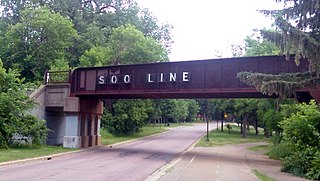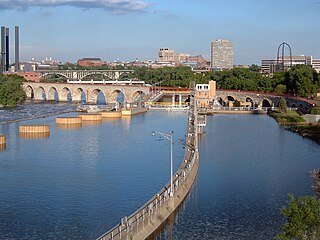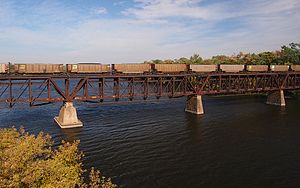
The Stone Arch Bridge is a former railroad bridge crossing the Mississippi River at Saint Anthony Falls in downtown Minneapolis, Minnesota. It is the only arched bridge made of stone on the entire Mississippi River. It is the second oldest bridge on the river next to Eads Bridge. The bridge was built to connect the railway system to the new Union Depot, which at that time was planned to be built between Hennepin Avenue and Nicollet Avenue. The bridge was completed in 1883, costing $650,000 at the time. 117 Portland Avenue is the general address of the historic complex.
Minnesota State Highway 23 (MN 23) is a state highway that stretches from southwestern to northeastern Minnesota. At 343.723 miles (553.169 km) in length, it is the second longest state route in Minnesota, after MN 1.

The Short Line Bridge is a truss bridge that spans the Mississippi River in Minneapolis, Minnesota, United States. It was originally built in the 1880s and upgraded a few years later by Chicago, Milwaukee, St. Paul and Pacific Railroad and was designed by American Bridge Company.

Northern Pacific Bridge #9 is a deck truss bridge that spans the Mississippi River in Minneapolis, Minnesota, between the Seven Corners area and the University of Minnesota campus. It was built in 1924 and was designed by Frederick W. Cappelen. Railroad use of the bridge ended in 1981, and in 1999 the bridge was opened to bicycles and pedestrians. It replaced the former Northern Pacific "A Line" bridge.

The La Crosse Rail Bridge is a swing bridge that spans the Mississippi River between La Crescent, Minnesota and La Crosse, Wisconsin. The first bridge in this location initially was designed and ready to build by June 1876, and was completed in November 1876 by the Milwaukee and St. Paul Railway, a predecessor of the Chicago, Milwaukee, St. Paul and Pacific Railroad. It was later replaced in 1902. It is at the Western end of the Canadian Pacific Railway Tomah Subdivision. Amtrak's Empire Builder crosses this bridge.

Minneapolis BNSF Rail Bridge is a combination plate girder bridge and truss bridge that spans the main channel of the Mississippi River between downtown Minneapolis, Minnesota and Nicollet Island in Minneapolis. It is located adjacent to the current Federal Reserve Bank of Minneapolis.

Broadway Avenue Bridge is a girder bridge that spans the Mississippi River in Minneapolis, Minnesota. Designed by Norman C. Davis and Shawn Pierson Bruns of Van Doren-Hazard-Stallings, it was built in 1987. The bridge has a rather streamlined shape, but its piers are more ornate. The piers have two flat columns that taper together, with a base that extends out to the full width of the bridge.

Northern Pacific-BNSF Minneapolis Rail Bridge is a combination plate girder bridge and truss bridge that spans the Mississippi River in Minneapolis, Minnesota.

Omaha Road Bridge Number 15 is a swing bridge that spans the Mississippi River in St. Paul, Minnesota, United States. It was built in 1915 by the Chicago, St. Paul, Minneapolis and Omaha Railway, though it, and the line from St. Paul to Mendota, was jointly owned with the Chicago, Milwaukee and St. Paul Railway. The causeway curves around Pickerel Lake in Lilydale, Minnesota, before crossing into St. Paul.

Canadian Pacific Camden Place Rail Bridge is a truss bridge that spans the Mississippi River in Minneapolis, Minnesota. This bridge is the official end of the navigable channel for river traffic. It was built in 1905 by the Minneapolis, St. Paul and Sault Ste. Marie Railway. In 1977, the bridge was modified to allow higher clearance under the center span. This was done by replacing the deck truss span with a shallower girder span. It is the main line crossing of the Mississippi River for the Canadian Pacific Railway transcontinental line.
University Bridge is a concrete girder bridge that spans the Mississippi River in Saint Cloud, Minnesota. Built in 1985 and designed by Howard Needles Tammen & Bergendoff, it is the second-newest bridge in St. Cloud, after Granite City Crossing. It is named for its proximity to St. Cloud State University. To accommodate bikers and walkers, the bridge has an approach ramp on one side and steps on the other side. For decoration, a scrollwork pattern is cut into the approach walls' concrete, and the piers are a curved "V" shape.

DeSoto Bridge was a trussed deck-arch bridge that spanned the Mississippi River in St. Cloud, Minnesota. It was built in 1958 by the Minnesota Department of Transportation. The bridge was painted black, which is typical for railroad bridges but unusual for a highway bridge. The river banks on either side are relatively high, so the bridge required deep trusses which arched over the river.

Veterans Bridge is a steel girder bridge that spans the Mississippi River in St. Cloud, Minnesota, United States. It was built in 1971 and was designed by Howard, Needles, Tammen & Bergendoff.

The Sauk Rapids Bridge was a steel spandrel braced arch bridge that spanned the Mississippi River between the cities of St. Cloud and Sauk Rapids in the U.S. state of Minnesota. It was built in 1942 and was designed by the Minnesota Department of Transportation. The bridge consisted of three spans supported by two piers. It crossed the Mississippi River one-half mile (0.8 km) downstream from the rapids of the Sauk River. The river is still rough and fast-flowing at this location.

Transportation in the U.S. State of Minnesota consists of a complex network of roadways, railways, waterways and airports. The transportation system is generally overseen by the Minnesota Department of Transportation, a cabinet-level agency of the state government. Additionally, regional governments such as the Metropolitan Council have authority over regional planning for the transportation system and local governments such as cities and counties oversee the local transportation network.

The Old Sartell Bridge is a bridge that spans the Mississippi River in the city of Sartell in the U.S. state of Minnesota. Though still standing, it is closed to traffic and was replaced by the Sartell Bridge constructed about 850 feet downstream. The bridge is around 1000 feet downstream of the Sartell Dam. The bridge was built during a six-month period in 1914, but over the years the bridge became congested and less able to carry heavy traffic. As early as 1957, heavy trucks were found to be too much for the span. When the new bridge was built in 1984, the old bridge was used as a pedestrian footbridge, but it became impractical for this use since there was a factory at the east end. The bridge now carries only utility lines.

Northern Lines Railway is a shortline railroad operating 17 miles (27 km) of track in and near St. Cloud in central Minnesota. The railroad was formed in 2004 to operate Burlington Northern Santa Fe trackage in the St. Cloud area and started operations in 2005. Interchange is made with BNSF in east St. Cloud.

Fridley station is a commuter rail station in Fridley, Minnesota, located at Main Street NE and 61st Avenue NE. It is served by the Northstar Commuter Rail line. The station features bicycle lockers and two park and ride lots with a total capacity of 611 spaces. The commute time to downtown Minneapolis from this station is about 20 minutes. The station has a single platform on one main track, which is accessible on either side of the tracks through a tunnel.
The Palisade Rail Bridge is a steel through truss bridge, originally built by the Minneapolis, St. Paul and Sault Ste. Marie Railway in 1910 to cross the Mississippi River at Palisade, Minnesota. The rail line was closed in 1985. Today, the bridge is part of the Soo Line North ATV Trail in northern Minnesota.
The Winona Rail Bridge was a swing bridge that spanned the Mississippi River between Winona, Minnesota, and Winona Junction in Buffalo, Buffalo County, Wisconsin. It was built to link the Winona and St. Peter Railroad with the La Crosse, Trempealeau & Prescott Railroad. Both became part of the Chicago and North Western Transportation Company (C&NW). The swing span was removed, but the box girder portion of the bridge still extends from Latsch Island just downstream of the current Main Channel Bridge. Piers from the original 1871 bridge and the box girders are in the North Channel just downstream of the current North Channel Bridge.

















